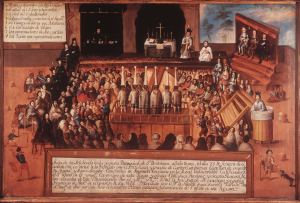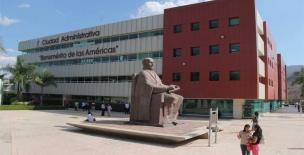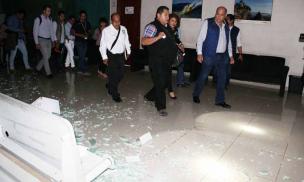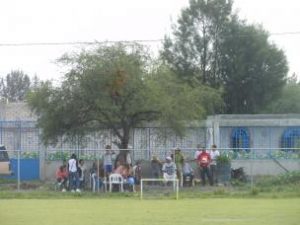
Jan 22, 2018 |
Daniela Gutiérrez Flores, PhD Student, Hispanic and Luso-Brazilian Studies
During the first half of the sixteenth century and before the establishment of the Inquisition in New Spain, idolatrous practices carried out by indigenous people were punished with extreme severity. This sparked a religious debate on how to deal with the newly converted subjects. American Indians, because they were considered ignorant new Christians, would be excluded from the jurisdiction of the Holy Office, whose operations pertained only to mestizos, Africans, creoles and Spaniards. Instead, a tribunal was specifically created to attend to the indigenous population: the Provisorato de Indios.[1]
Among the activities of this institution was the vigilance and extirpation of idolatry among indigenous peoples. The processes carried out by the Provisorato were commonly initiated by accusations made by individuals to fellow members of their community and, if grave, ended in an auto de fe. There were some cases, however, in which people turned themselves in. Such is the case of an indigenous woman who confessed to being a witch before Juan Ignacio Castorena y Ursúa, head of the Provisorato de Indios from 1709 to 1728.
-

-
Portrait of Juan Ignacio María Castorena Ursúa Goyeneche y Villareal, by Nicolás Rodríguez. Eighteenth Century. Media Library of the National Institute of Anthropology and History, National Museum of the Viceroyalty.
The eighteenth century saw big changes in the configuration of Mexican cities. Indigenous people had formerly occupied the margins of urban spaces, but gradually, many of these villages were integrated into bigger cities. This resulted in the introduction of syncretic unorthodox religious practices into urban life, a situation that certainly troubled religious authorities. The Provisorato was a key institution in the attempt to suppress the heterodox religiosity of the “rustic” groups that suddenly erupted in the cities. This is the context surrounding this indigenous woman’s confession.
The confession is preserved in a 1736 manuscript I have recently begun to examine. Because it is a testimony in the first person, it serves as a fascinating window into colonial religious practices and the process of self-fashioning before ecclesiastic authority.
The woman begins by narrating her childhood. She was born, we are told, in a family with a long tradition in sorcery and witchcraft. While she was still a baby, her parents gave her away to Lucifer, who became her “nagual.” This syncretic representation of the devil takes us back to the first contact between Spaniards and the indigenous peoples, when practices such as nahualismo were amalgamated under Catholicism as evidence of the devil’s presence in the Americas. In the religion of the Ancient Mexicans, the term nahualli designates the spiritual companion or “alter ego” of a person, which usually takes the form of an animal.[2] From the beginning of her confession, the woman represents herself through duality. The devil is certainly an intrinsic part of who she is, but reason—and with it, the possibility of redemption—still lies within her.
-

-
Detail of the manuscript. Courtesy of the Nettie Lee Benson Latin American Collection, University of Texas at Austin.
She then goes on to tell us how Lucifer raised her: he taught her to walk, to dress, to make her bed. He gave her baby animals to play with and took her on walks through the maize fields. The devil is portrayed as a maternal loving figure, a “chichigua” (wet nurse) who nurtured her with knowledge about witchcraft, but also with practical everyday-life skills. Perhaps one of the most interesting characteristics of this testimony is precisely the connection drawn between the fantastic world of flying shape-shifting witches and the mundane life of common individuals. The devil and the witch, far from being esoteric figures, are placed here in the concrete, familiar contexts of colonial life.
When the woman grows older, she marries Lucifer in a big celebration in which guests danced to the dance of the Moors and the Christians (a traditional Spanish dance that enacts Christian domination over the Moors, but that in the Americas was adapted to dramatize the process of colonization). In this dance, our witch plays la Malinche—Hernán Cortés’s famous interpreter and mistress—and, thus, the devil plays the conquistador. Through this dramatization, both Cortés and La Malinche emerge as demonical figures. Her union to Lucifer mirrors that between Spaniards and Mexicans, symbolically making mestizos the offspring of a diabolical alliance.
As a wife, the witch gains deeper knowledge about demonic customs, acquiring higher powers and ascending in satanic hierarchy thanks to her superior talent. She recounts explicit tales about raping sleeping nuns, eating babies in tamales, using their blood to knead tortillas and even murdering her own mother at her father’s request (he had grown bored of her). She becomes the new head of her family and a sort of “First Lady” of the Satanic Church, accompanying Lucifer in his travels around the world.
Out of this document emerges a strong female voice that freely brags about her power and talent with deep pride. Her association with Lucifer allows her to occupy a position in society that is not typically reserved for women: she replaces patriarchal authority in her own family, annuls her maternity by eating her children, satisfies her sexual desires unrestrictedly and even challenges the authority of Lucifer himself. When demanded to sacrifice the only son she has ever been fond of, she protects the baby by offering him to the Virgin of Guadalupe. Reciprocally, the devil does not act according to “traditional” masculine roles. He helps women in domestic tasks—such as grinding nixtamal to make tortillas—so that they do not exhaust themselves with too much housework. At Lucifer’s side, the woman has radical liberties that she does not find in her earthly Christian marriage to an Indian cacique. With her human husband, who ignores her true identity, she says the “worm” of her desire has died and she feels condemned to die “dumb.”
How were all of these tales received by the authorities in the Provisorato de Indios? The final whereabouts of this witch are a question I have yet to answer. She may have been processed, or perhaps the gravity of her crimes was lessened by the fact that she confessed. Indeed, her insisting reiteration about her demonic lineage, along with her representation of confession as an act of rebellion against Satan, seems to constitute a strategy for attenuating her culpability. In representing herself as an ignorant, irrational woman who was “fooled” into worshiping the devil by her family, she would have been able to protect herself while simultaneously talking extensively about her past. Regardless of her final destiny, this unique document shows how colonial subjects manipulated existing religious discourse to negotiate their position in an ever-changing society.
-

-
An auto de fe in the town of San Bartolomé Otzolotepec”. Eighteenth Century. National Museum of Art, INBA, Donation of the National Fund for the Arts and Culture, 1991.
[1] See Gerardo Lara Cisneros, ¿Ignorancia invencible?: superstición e idolatría ante el Provisorato de Indios y Chinos del Arzobispado de México en el siglo XVIII, UNAM: México D.F., 2014.
[2] See Roberto Martínez González, “Bruja y nahualli: versiones y perversiones en el proceso colonial,” Cyber Humanitatis, Universidad de Chile, Nº48 (Primavera 2008).

Dec 15, 2017 |
Chris Gatto, PhD Candidate, History
On Thursday, September 7, 2017, a magnitude 8.1 earthquake struck off the Pacific coast of Mexico, killing over 100 individuals and damaging thousands of homes in the southern states of Chiapas, Oaxaca, and Tobasco. This was the strongest earthquake the country had experienced since 1787. While earthquakes are a fairly common occurrence in Mexico, this particular event caused more alarm and destruction than could have ever been anticipated.
The earthquake struck at approximately 11:30 pm, and I acutely remember standing in the bathroom of my Airbnb in Oaxaca City, brushing my teeth and getting ready to go to bed. I was concluding nearly two months of archival research in Oaxaca for my dissertation, entitled “From Cochineal to Coffee: The Making of a New Rural Society in Miahuatlán, Oaxaca, 1780–1880.” The door to my small apartment began to shake violently, and my initial thought was that someone was trying to break in. As I walked over to see what was happening, I immediately fell to the ground, as the floor beneath me began to shake. The power in the city then went out, and in complete darkness it became all too clear to me and everyone else in the city what was occurring.
While my first thought was to text my anxious mother (before she uncovered the news of the earthquake on her own), I then began to consider how this would affect the work I still needed to get done. I was finishing nearly six weeks of research in the Archivo Histórico de Notarías, a vast archive inside the Church of Santo Domingo right in the heart of Oaxaca City. This archive is home to nearly 2,000 volumes of notarial documents from the early 17th century all the way up until the 20th century, including land purchases and rentals, wills, contracts, and inventories. Needless to say, this archive plays an essential role in my dissertation, which explores the dramatic agricultural transformation that occurred in the southern part of the state from cochineal to coffee cultivation over the course of the 19th century.
The Archivo Histórico de Notarías is now fully digitalized, but researchers still need to spend considerable amounts of time with the original documents, identifying book and page numbers before proceeding to the Dirección General de Notarías, an office located in the Ciudad Administrativa about 15 minutes outside of the city, to begin a complicated process (trámite) of requesting digital copies. While I knew the Archivo itself would be closed for several days (as it was, although thankfully with limited damage), I was also concerned about the Ciudad Administrativa, where I needed to travel with a flash drive to collect all the images I had been identifying over the past month.
-

-
The main square of the Ciudad Administrativa on an average day
-

-
Ciudad Administrativa after the earthquake
-

-
Ciudad Administrativa after the earthquake
The first image above depicts the main square of the Ciudad Administrativa on an average day, while the next two images reflect the damage suffered following the earthquake. Suffice it to say, these offices would not reopen for quite some time, as government workers refused to return to the campus until proper working conditions had been restored. I remember visiting the Ciudad Administrativa during that week, hoping I could find someone, anyone, that could help me gain access to the hard drive and expedite the transfer of images. However, I was promptly turned away, as they insisted I would have to return the following week. Unfortunately, I did not have another week, and I flew back to Chicago on September 16 with the sick feeling that so much time and effort had been expended for nothing. While I was determined to return to Oaxaca soon to complete my research, I knew there were further challenges I would eventually have to overcome…
-

-
Protests at the Ciudad Administrativa
-

-
Protests at the Ciudad Administrativa
The Ciudad Administrativa, along with the Ciudad Judicial, are the two largest government offices in Oaxaca. However, on any given day, access to these offices is severely restricted, since they become the site for a range of protests from different social organizations and unions across the region, including taxi drivers (taxistas), teachers’ unions (maestros), and indigenous rights activists. These groups block access to the Ciudad Administrativa in different and often inventive ways (as shown in the images above), and when this happens, nobody can enter or leave the campus until the groups disassemble. These protests have become so routine that the public has become accustomed to the disruptions and adjust their schedules accordingly. Whatever one thinks of the validity of these protests (I happen to be quite sympathetic), they cause significant disturbances in the life of ordinary residents in the city, and you will often hear people expressing sympathy for the causes but not necessarily the tactics.
In organizing my trip back to Oaxaca, I knew I would have to allow several days for a procedure that should only take a couple hours. On the week of October 23, 2017, I flew back to Oaxaca, allowing five days (Monday through Friday) to get my work completed. I anxiously checked my Twitter feed on an hourly basis to identify reports of potential blockades (bloqueos) at the government campus. As it turns out, I was able find a small window early Tuesday morning to enter the Ciudad Administrativa and complete the process of acquiring nearly 1,000 images that will hopefully form an important part of my dissertation. Shortly after I entered, the campus was closed off, and we could not leave until 6pm that evening. The campus experienced similar protests on Wednesday, Thursday, and Friday of that week, and thus I was incredibly fortunate to find the small window that I did to get my work completed.
Researchers in Mexico and across Latin America face these types of logistical challenges on a regular basis, and I do not mean to suggest that what I have faced is unique or atypical in any way. But my work in Oaxaca does show how precarious the work of historians can be, given that we are forced to rely on documents that readily become available or unavailable according to shifting circumstances beyond our control. I hope my dissertation can make good use of the materials I have been lucky enough to uncover, and shed light on historical processes that help us better understand such a dynamic and important region of Mexico.
Nov 30, 2017 |
Agnes Mondragon Celis Ochoa, PhD student, Anthropology

Photo by Toni François
Santa Muerte, a folk saint so little known before the turn of the century—in a religious landscape mostly populated by centuries-old figures—has become widely present in the Mexican public sphere in the past few years and, just as quickly, has been associated with criminality and drug violence in the media. This association has depicted Santa Muerte’s followers not only as criminals themselves, but also as engaging in illegitimate, even blasphemous, devotional practices. While this mass-mediated association resonates with old, Porfirian-age and ultimately colonial discourses linking Mexican lower classes to criminality —which of course, says more about class hierarchies in Mexican society than about Santa Muerte devotees themselves—I consider there to be, indeed, a relation between this saint and violence that remains unexplored. By examining a collective ritual that takes place in Santa Muerte’s main shrine in the downtown slum of Tepito, Mexico City, I wish to explore one of the ways in which such a relation plays out.
Tepito is a neighborhood best known for its massive informal market—where, allegedly, one can buy commodities of all imaginable kinds—but is also remarkable for its strong communal identity, which claims a pre-Hispanic past and which was able to resist gentrification efforts by the local government . It seems to have harshly felt the well-known effects of neoliberalism: unprecedented flows of money (especially of illegal trades), greater inequality, harsher capitalist competition, and the violence this brings about. The practices surrounding Santa Muerte, I argue, are means through which this violence is collectively acknowledged, evaluated and addressed, while offering a space by which the community of devotees reminds itself of such a fact and (ritually) reconstructs social bonds, which are crucial for both collective and individual survival.

Photo by Saúl Ruiz
On the first day of the month, devotees gather around the Santa Muerte shrine well before the main ceremony. Many are seen close to their Santa Muerte icons, either because they are holding them in their arms [image 1] or because they have placed them over a piece of cloth on the floor, like small, improvised shrines [image 2]. All sorts of small objects—candies, toy bills, beaded bracelets—can be seen in people’s hands or adorning their statuettes. The objects are gifts brought and distributed by devotees in return for miracles granted by Santa Muerte. As has become customary, devotees bring many such objects, which indicates the magnitude of the intended repayment. Devotees will offer them as gifts to several of the numerous Santa Muerte statuettes gathered on that day—insofar as all are equally indexes of the same Santa Muerte. While offering the saint her gratitude, however, it becomes unclear whether the recipient of the gift is Santa Muerte or (also) the devotee carrying the icon. Moreover, the gift is usually accompanied by a que te cuide y te proteja, “may she look after and protect you”, whose target is clearly a fellow devotee. In this way, the gift giver is demonstrating Santa Muerte’s efficacy to the recipient and encouraging others to engage in or maintain relations with her. As anthropologist Timothy Knowlton shows for a similar ritual, [5. Timothy Knowlton, “Inscribing the Miraculous Place: Writing and Ritual Communication in the Chapel of a Guatemalan Popular Saint”, Linguistic Anthropology, 25(3), December 2015] these individual communicative acts, superimposed on each other—as can be seen in the accumulation of gifts adorning the statuettes [image 1]—constitute and help sustain this collective devotion overtime.
But there is more to this. Gift giving, one of the classical concerns in anthropology, has been found to be at the very foundation of sociality, as acts that inaugurate (or, in our case, reestablish) social bonds and that carry the obligation to reciprocate. Following Nancy Munn, a gift may initiate a reciprocal transaction, and thus a social bond—a connection between the two persons involved where the gift giver is constituted and remembered as a generous person and her action reciprocated through a return gift sometime in the future.
This logic of reciprocity, although inverted, appears in devotional practices through which Santa Muerte followers attempt to harm others, to retaliate against others’ abuses of power or to counteract a competitor’s conspicuous economic success, situations that have become increasingly common, as mentioned, in recent years. The possibility to engage in these harmful practices, however, comes with a warning: Santa Muerte takes a loved one if a devotee fails to repay a favor. In other words, Santa Muerte takes revenge by mirroring the devotee’s harmful act, and thus breaking this devotee’s network of social bonds in the same way that she mirrors a devotee’s thankful repayment by creating a new social bond through gift giving, as the ritual above describes.
Knowledge about Santa Muerte’s revengefulness, for devotees, is thus a recurrent reminder about the perils of destroying social relations. Communal ritual practices not only result from the collective acknowledgment that a network of friends and kin is fundamental for everyday survival—especially in communities that have faced the hardships of poverty —but also that violence is ultimately unsustainable for social life. Santa Muerte followers then gather once a month in order to ritually suture back these severed bonds. In this way, the community becomes an agent that sustains itself into the future.
Oct 31, 2017 |
Franco Bavoni Escobedo, MAPSS AM’16

Chicago hosts the second largest Mexican community in the United States after Los Angeles. Between 2010–2014, 669,000 Mexican migrants resided in the metropolitan area, representing 7% of the total population and 40% of the foreign-born population. Unsurprisingly, scholars and observers alike adopted the idea of a “Mexican Chicago.” Contrary to what some might think, however, Mexican Chicago is more than the mere presence of Mexicans in Chicago. As Nicholas De Genova argues, Mexican Chicago is produced through migrants’ everyday-life practices, which tie this space irreversibly to Mexico and, at the same time, render it irretrievable for the US nation-state. This is not to say that Mexican Chicago pertains to the Mexican nation-state. Rather, says De Genova, it is the result of migrants’ particular social situation through which the meaning of “Mexican” itself comes to be reconfigured. Thus, Mexican Chicago has to be constantly reworked and reproduced through social interaction.

Few spaces are as emblematic of Mexican Chicago as the numerous Hispanic soccer leagues that exist in the city. A steady stream of new Mexican migrants after World War II, combined with soccer’s dramatic expansion south of the border, led in the 1970s to what David Trouille calls the “Latinization” of the game. The foundation of the Chicago Latin American Soccer Association (CLASA) in 1973 was followed by the exponential growth of Mexican soccer in the next decades. According to Raúl Dorantes and Febronio Zatarain, the main four leagues average 7,000 members each, but the total number of registered players in the Chicago metropolitan area is close to a quarter million.
So how does one experience Mexican Chicago through soccer? The answer is not straightforward. My fieldwork with San Rafael, a Chicago-based team founded by migrants from a rural town of the same name in Michoacán, reveals how varying sets of relationships and situational factors can alter the meaning of “Mexican” in Mexican Chicago. A very brief comparison between the summer and winter seasons proves illuminating in this regard.
Summer Season

An atmosphere largely reminiscent of rural Michoacán characterizes the summer season games. Although many players are of the 1.5 and second generations, most supporters are first-generation migrants who have lived several years in the United States. As Luis Escala-Rabadán points out, participants “reconstruct their place of origin” through the soccer experience despite being far away from it. For example, since the heat in both San Rafael and Chicago is usually intense, attendees north and south of the border congregate under the trees to seek refuge from the sun and chat. In both locations, Mexican snacks, chicharrones, are available for purchase on the sidelines of the field. Whether in Chicago or San Rafael, most participants also enjoy a few beers while watching the game, and drinking continues for hours afterwards. Moreover, soccer games in both sites pit teams that represent specific towns against each other, which reinforces a sense of pride among participants. Finally, in both Mexico and the United States conversations are in Spanish.
Besides the similarities between both sites, attendees in Chicago intensify their sense of proximity to San Rafael by talking about the town and using certain idiosyncratic references that only someone from the pueblo would understand. For instance, they often talk about belonging to los de arriba or los de abajo (those from above or from below). The dividing line is the village’s church. Those whose homes are located before it are from abajo, while those who live after it are from arriba. In Chicago the distinction is mostly used to joke around: Rodrigo, without hesitating, teasingly refused to give Óscar a ride because he was from arriba. Thus, during the summer season, “Mexican” acquires a very specific meaning for first-generation supporters: as one of them put it, “it’s all about meeting with the people from the pueblo.”
Winter Season

At la Pershing, the facilities where the San Rafael indoor soccer games take place, things are different. The first-generation supporters from the town are mostly absent, and players are predominantly of the 1.5 and second generations. Still, the space is filled with Mexican features. As one enters the premises, the booming Mexican music can be immediately heard. The majority of players wear Mexican teams’ jerseys, and the multiple screens show the Mexican soccer league on Univision, a Spanish-language television network. Next to a cash register there is an image of the Virgin of Guadalupe, another conspicuous symbol of Mexicanness.

However, instead of vendors selling chicharrones, there is a fast food restaurant where customers can buy American food such as hot dogs, popcorn, and nachos. Whereas the use of English is extremely limited in the summer, the norm at la Pershing is a combination of both languages. On and off the soccer field, continuous code switching between Spanish and English soon becomes apparent. There is also a store where people can acquire sports equipment. When I walk in and ask for shin guards in Spanish, the clerk asks me to please repeat my question in English, as she cannot understand. It then dawns on me: this is just another face of Mexican Chicago, no less Mexican than the one that emerges during summer season games. As a 1.5-generation player told me, this is an opportunity to feel “more Mexican” as opposed to feeling “more American” while at work.
In sum, although the San Rafael soccer team is doubtlessly embedded in Mexican Chicago, its meaning varies significantly in different settings and according to the actors involved. However, this is just the first step of the analysis. As Lisa Wedeen argues, the importance of these practices does not reside simply in what they mean to their practitioners, but also in the ways in which they produce specific logics and generate observable political effects. That is, precisely, the goal of my research.
References
- De Genova, Nicholas. 1998. “Race, Space, and the Reinvention of Latin America in Mexican Chicago,” Latin American Perspectives, 25: 87–116.
- Dorantes, Raúl and Febronio Zatarain. 2007. …Y nos vinimos de mojados: cultura mexicana en Chicago. Mexico City: Universidad Autónoma de la Ciudad de México.
- Escala-Rabadán, Luis. 2012. “Migración, redes sociales y clubes de futbol de los migrantes hidalguenses en Estados Unidos.” In Offside/Fuera de lugar: futbol y migraciones en el mundo contemporáneo, edited by Guillermo Alonso Meneses and Luis Escala-Rabadán, 133–150. Tijuana: El Colegio de la Frontera Norte.
- Trouille, David. 2008. “Association Football to Fútbol: Ethnic Succession and the History of Chicago-Area Soccer since 1920,” Soccer & Society, 10: 795–822.
- Wedeen, Lisa. 2008. Peripheral Visions: Publics, Power, and Performance in Yemen. Chicago: The University of Chicago Press.
Jan 19, 2017 |
Valeria López Fadul, Provost’s Postdoctoral Scholar, History
There was once in Mexico City a painter named Baltasar de Echave. It was a time (the early seventeenth century) when the city’s Basque community was thriving. Echave, a man of distinction, grew increasingly concerned with what he believed to be the demise of the Basque language. The New World and its promises of gold and never-ending wealth lured many young people into perpetual exile from their ancestral homelands in the Iberian Peninsula, causing them to abandon their ancient estates. When these men and women reached the Indies their descendants adopted Castilian for convenience and abandoned Basque. In the same way that the disappearance of the Taínos of Hispaniola brought about a formal end to their spoken tongues, Echave feared that Basque too would fade away.[i]
The languages of the Caribbean were declining, their only vestiges the islands’ place names. But the situation of Basque could still be reversed. This compelled Echave to publish a treatise entitled the Discursos de la antigüedad de la lengua Cántabra-Bascongada in 1607. In it he celebrated his language’s nobility and expressive qualities.
Above all, however, Echave’s treatise stressed the antiquity of Basque. Like many other early modern thinkers, Echave believed that Basque had been the primordial and most widespread tongue of Spain and that it held a special place amongst the languages of mankind, including those spoken in the Americas. Furthermore, Echave trusted that the rapidly changing linguistic situation of the Indies could illuminate many of the forces that had acted upon Basque before histories were recorded. It could help show how this once general tongue was now spoken only by a few.
In other words, an understanding of the history and development of ancient indigenous societies like those of Mesoamerica or the Andes region together with the many demographic, political, economic, and environmental transformations brought about by one hundred years of Spanish rule could serve scholars like Echave “as examples and live portraits of what it was once like in the Old World.” Language and its transformations represented a way to stream back to the unrecorded past, to gain insight into the experiences of previous generations, to learn about people’s origins and the histories of the regions they inhabited. Language was an archive of knowledge.
The early modern Hispanic territories, like all pre-modern societies, were multilingual. The Spanish king viewed this polyglossia as a necessary corollary of ruling over the wide array of lands, climates, and natures that made up his vast composite realms. Writers of all genres were invested in studying languages and considered the knowledge that words contained as central to resolving a great variety of questions. Etymology, or the study of names, had the capacity to reveal great amounts of information about the objects that words signified and could be approached in diverse ways. These ranged from the exegetical to the mystical, to the historical, to the philosophical. Place names contained traces of their founders. The names of plants and animals revealed traces of those who had named them. The words used to designate objects and rituals betrayed clues about their purposes and functions.
Pages upon pages of etymological discussions abound in the writings of the first chroniclers of the Indies. Throughout the course of my research on the philosophy of language in early Latin America I came to appreciate the significance of these extensive linguistic digressions. They offer a window into the ways in which native authorities explained the foundation of their towns, their genealogies, and the order of the flora and fauna that surrounded them.
The island of Hispaniola, only recently known by its Hispanic appellation, was actually, and more meaningfully, called Haití. Pietro Martire d’Anghiera (1457–1526), like most sixteenth-century chroniclers of the Indies, began his history of the Caribbean by presenting the etymology of the words that the natives used to designate their homeland. He distinguished between their ancient language and their current one and attempted to explain the reasoning behind the toponyms. The primitive inhabitants of those islands had given first the name of Quizqueia and then Haití to Hispaniola. These denominations, he warned, “were not the children of fickleness, but of the meaning that they had.” Quizqueia is “a big thing that does not have an equal.” This word signified “vastness, universe, everything.” Martire compared this name to the word Pan (all) that the Greeks used to refer to their islands, since, like the Caribbean Indians, they believed that their “magnitude was the whole orb, and that the sun does not warm anything else [but theirs] and the neighboring islands.”
Haití was equally expressive. It signified, in the ancient language of the islanders, roughness. The natives of Haití applied the designation to the whole territory, through metonymy. In many parts of Haití “expanses of steep mounts can be found, thick and terrifying jungles, and fearful and dark valleys given the altitude of its mounts, and in other parts it is very pleasant.” In their use of metonymy, Martire reflected that the Indians resembled the poets that sometimes referred to all of Italy as Lazio (Latium), which was formally the name of one central region. Quizqueia contained clues as to the native’s worldview and Haití information about the physical landscape of the island.[ii]
Martire’s intellectual rival Gonzalo Fernández de Oviedo (1478–1557) used the study of names to convey his authoritative eyewitness status when describing countless plants and animals previously unknown to Europeans. The iguanas that lived throughout the islands and on the mainland were not, as Martire had claimed, similar to the crocodiles of the Egyptian Nile. These new world “dragons” were much smaller than those creatures. It was unclear to Oviedo whether they were aquatic or terrestrial and whether they could be consumed during Lent. That was best for each to decide.
Despite his uncertainties, Oviedo could attest to their size, since he had seen many of them and even kept a few in his home. The “yuana,” he explained meticulously, “is pronounced y and after a short interval u and then the three subsequent letters ana are uttered together, and in this way in the whole name [one] makes two stops in the manner in which it has been described.”[iii] Oviedo went to great pains to replicate the sounds of the animal’s native name.
When Echave published his book 50 years after the death of Oviedo, his friend Fernándo de Ojeda composed a short prologue to exalt the treatise’s accomplishments. Thinking about the linguistic change that had ensued since the arrival of the first Spaniards as a consequence of conquest and population demise, Ojeda challenged the notion that the spread of empire is always accompanied by the complete linguistic assimilation of those defeated. “Even though it is true,” Ojeda conceded, “that, as it has always been said, conquerors and their languages consume the speeches of vanquished peoples: This does not apply to the names of provinces, mountains, rivers, and springs, even if they are a bit altered, as we experience in the infinite provinces of these Indies, which still conserve with little variation its ancient names, because even though we renamed many of them in the Spanish fashion: these have been forgotten or have fallen out of use altogether and the old names of the Indians prevail, even after all of them have died-out in some parts.” Ojeda presented the case of the Caribbean islands and other regions in the mainland, like “Cuba, which the Spaniards named in the beginning Fernandina,” and also “in Habana, Bayamo, Jamayca, Yucatan, Chapultepec, Campeche, Mexico, Mechuacan, Tezcuco, Tlaxcala and Cholula, which are all Indian words.”[iv] The omnipresence of long-winded and excruciatingly detailed etymological discussions, despite seeming fantastical and naive to a modern reader, reveals just how central they were to the early modern scholar in ascertaining and presenting to a distant audience reliable and authoritative local knowledge.
 Detail from Abraham Ortelius’ map of Cuba and surrounding islands showing the names Hispaniola and “Ayti.” Abraham Ortelius, “Hispaniolae, Cubae, aliarumque insularum circumiacientium, delineatio,” Theatrum orbis terrarum (Antwerp: Plantin Press, 1598). Courtesy of the John Carter Brown Library at Brown University.
Detail from Abraham Ortelius’ map of Cuba and surrounding islands showing the names Hispaniola and “Ayti.” Abraham Ortelius, “Hispaniolae, Cubae, aliarumque insularum circumiacientium, delineatio,” Theatrum orbis terrarum (Antwerp: Plantin Press, 1598). Courtesy of the John Carter Brown Library at Brown University.

Detail from Gonzalo Fernández de Oviedo’s Historia general y natural de las Indias. 1a. parte (Sevilla: En la emprenta de Juana Cromberg, 1535). Courtesy of the John Carter Brown Library at Brown University.
Footnotes
[i] Baltasar de Echave, Discursos de la antiguedad de la lengua Cántabra-Bascongada compuestos por Balthasar de Echave, natural de la Villa de Çumaya en la Provincia de Guipuzcoa, y vezino de Mexico.(Mexico : Henrrico Martínez, 1607), 83r.-84v.
[ii] Pietro Martire d’Anghiera, Décadas del Nuevo Mundo, trans. by Edmundo O’Gorman (México: J. Porrúa, 1964), 2 vols., Decade III, Book VII, p. 351.
[iii] Gonzalo Fernández Oviedo, Historia General de las Indias, islas y tierra firme del mar océano (Madrid: Imprenta de la Real Academia de la Historia, 1851), Book XII, Cap. VII, pp. 392-396, p. 393.
[iv] Fray Hernando de Ojeda, “ Fray Hernando de Ojeda de la orden de Santo Domingo a su amigo, Balthasar de Echave en loor de esta obra,” in Echave, Discursos de la antiguedad de la lengua Cántabra-Bascongada.
The contents of this blog do not necessarily reflect the views of the Center for Latin American Studies or the University of Chicago.


















 Detail from Abraham Ortelius’ map of Cuba and surrounding islands showing the names Hispaniola and “Ayti.” Abraham Ortelius, “Hispaniolae, Cubae, aliarumque insularum circumiacientium, delineatio,” Theatrum orbis terrarum (Antwerp: Plantin Press, 1598). Courtesy of the John Carter Brown Library at Brown University.
Detail from Abraham Ortelius’ map of Cuba and surrounding islands showing the names Hispaniola and “Ayti.” Abraham Ortelius, “Hispaniolae, Cubae, aliarumque insularum circumiacientium, delineatio,” Theatrum orbis terrarum (Antwerp: Plantin Press, 1598). Courtesy of the John Carter Brown Library at Brown University.